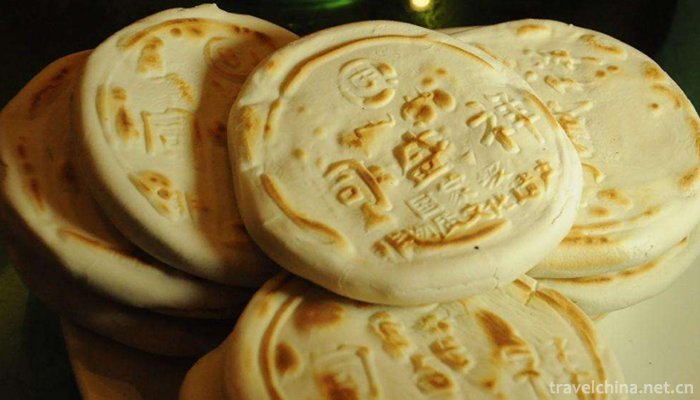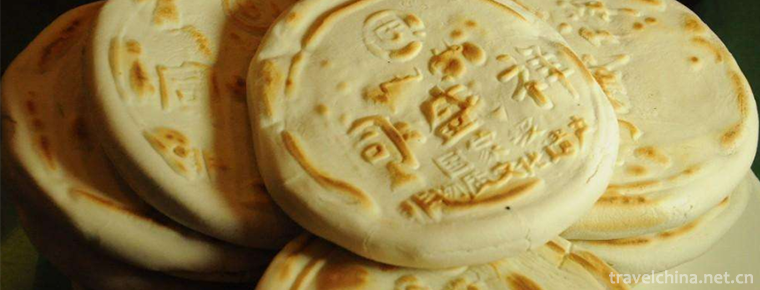Production Techniques of Tongshengxiang Beef and Mutton Bubble
Production Techniques of Tongshengxiang Beef and Mutton Bubble
Tongshengxiang beef and mutton steamed bread making skills, Shaanxi Province, the local traditional handicraft, one of the national intangible cultural heritage.
Tongshengxiang steamed beef and mutton steamed bun was founded in 1920. It was named Tongshengxiang with the meaning of "prosperity and auspiciousness". Its steamed bread is made of meat of choice mutton. It has exquisite cooking skills, unique flavor, strong rotten broth, smooth steamed bread, delicious taste and attractive appetite.
In 2008, Tongshengxiang beef and mutton steamed bun making technology was approved by the State Council and listed in the second batch of national intangible cultural heritage list, the heritage number is_-165.
historical origin
Mutton steamed bun has a long history. In the pre-Qin period, there were rituals of "offering lambs to sacrifice leeks" and "killing lambs" when offering sacrifices to ancestral temples and entertaining guests.
According to legend, steamed beef and mutton steamed buns originated in the 11th century BC and evolved on the basis of "steamed beef and mutton". In the Western Zhou Dynasty, "Niu Yang Xiu" was listed as the "rituals" of kings and princes.
During the Northern and Southern Dynasties, Mao Xiuzhi offered this wonderful taste to Emperor Wudi of Song Dynasty, and Emperor Wudi even named him a Taiguan official.
In the flourishing Tang Dynasty, the Muslims who settled in Chang'an continuously improved on the basis of the ancient soup of sheep, especially the use of "Tulmu", or bun, which formed today's soup of beef and mutton. It can be seen that beef and mutton steamed bun is the product of the interaction between the Central Plains culture and the Western Regions culture and the integration of the Han and Hui ethnic diet culture. According to the different cooking methods, steamed bun can be divided into four types: dry soak (no soup), mouth soup (one soup after eating), Shuiweicheng (more soup) and single-walker (steamed soup).
Su Shi, a poet of Song Dynasty, praised the folk ballad of "Longxiang has bear wax, Qin cooks only lamb soup" and "Chang'an City is mentioned, the name of Lamb Soup is often remembered; lamb soup tastes delicious, only belongs to the same prosperity". This is not only the ancient people's nostalgia for Shanxi cuisine, but also the modern people's sincere admiration for Tongsheng soaked soup. Beef and mutton soup is also deep. It is deeply imprinted in Shaanxi culture.
Tong Shengxiang was founded in 1920 and named Tong Shengxiang as "Tong Shengxiang" in the sense of "Tong Shengxiang".
Technological characteristics
Tongshengxiang beef and mutton steamed bread is heavy and mellow, with thick rotten meat soup, smooth steamed grain, overflowing aroma and unique flavor. Its production process is very sophisticated, from material selection, meat boiling, soup boiling, feeding, seasoning to steamed buns always adhere to fine, standard and standard.
Tong Shengxiang's steamed bun pays attention to the appearance of "meat is like two fish, fans are like spider webs", but authentic and authentic food, which also pays attention to: when eating, first put coriander and spicy sauce on the steamed bun, the coriander kills the smell, spicy sauce stimulates appetite, and then choose the orientation, step by step, always from one place along. Planing food at the edge of the bowl, avoid stirring back and forth, in order to maintain the fragrance of steamed beef and mutton, some people call this eating method "silkworm".
Inheritance and Protection
Inheritance value
Beef and mutton steamed bun is a unique nourishing food with warm stomach function. It has long been loved by people in Shaanxi and even northwest China.
Heritage figures
Wuping, selected as the representative successors of the fourth batch of national intangible cultural heritage projects on July 16, 2014, will be declared by Xi'an City, Shaanxi Province.
protective measures
Tong Shengxiang trains the chefs every year, and compares the chefs'cooking skills every year to test the chefs' practical operation ability. In this way, it not only guarantees the quality of Tongshengxiang steamed beef and mutton, but also promotes the inheritance and protection of intangible cultural heritage.
Tongshengxiang beef and mutton steamed bun formulated strict operating rules, developed and introduced hundreds of Muslim flavor dishes, and created a unique "steamed bun banquet", introducing mutton, lamb steamed bun, mutton stir-fry and other Muslim flavor snacks into the banquet.
Tongshengxiang beef and mutton steamed bun in order to improve the competitiveness of the business, strategic out of Shaanxi, in Beijing, Zhengzhou, Harbin and other places to set up branches.
social influence
Domestic impact
In November 1984, Tong Shengxiang sent two steamed bun technicians to Beijing Diaoyutai State Guest House to perform their skills, which was praised by the relevant leaders of the Central Committee.
In 1985, Tong Shengxiang performed mutton steamed bun in the report form of Beijing National Culture Palace and went to the chef of Diaoyutai State Guest House to make the steamed bun glorious at the state banquet.
In July 2008, Ma Guijun, the successor of Tongshengxiang Bubble, went to Beidaihe to produce "Bubble Bubble of Beef and Mutton" for the central leadership.
From April 6 to 10, 2012, the third "Western intangible cultural heritage exhibition" was held in Xi'an with the steamed beef and mutton of Shengxiang Restaurant.
Honorary recognition
In 1989, Tongshengxiang Food Farm won the Golden Ding Award of the Ministry of Commerce of the People's Republic of China for its beef and mutton steamed bun.
In 1993, in the third National Culinary Competition, the Muslim dishes with Shengxiang won the gold medal.
In 1994, Tong Shengxiang won the gold medal in the first National Muslim Cuisine Competition.
In 1997, Tong Shengxiang's big bowl of mutton steamed bun participated in the "Chinese Famous Snacks Recognition Meeting" held in Hangzhou. Tong Shengxiang's beef and mutton steamed bun and mutton pie were named "Chinese Famous Snacks" by the Chinese Cooking Association.
international repercussions
In the early 1950s, the mayor of Xi'an, Zhang Fengbo, had a banquet with Marshal Helong at Tongshengxiang Restaurant. Since then, Premier Zhou Enlai, Vice Premier Chen Yi, and other guests such as King Mahendra of Nepal, President Ho Chi Minh of Vietnam and Marshal Montgomery of Britain have been invited to dinner in this restaurant.
In 2006, the "Tongshengxiang" Green Shade Cattle Exhibition and the "Five Rings Cowtail" were listed as the recommended recipes for the 2008 Olympic Games at the "Second" China Food and Beverage Exposition.
In August 2008, after the daughter of IOC President Rogge, Carolina Rogge, and daughter-in-law Sabina Rogge tasted Muslim delicacies in "Tongsheng", they continued to praise OK.


-
1.Xiangsha Bay Scenic Spot in Dalat Banner Ordos
Xiangsha Bay was opened as a tourist attraction in January 1984, listed as a national line scenic spot by the National Tourism Administration in 1991
Time 2018-11-29 -
2.Xiantan Mountain Hot Spring Town
Xiantan Mountain Hot Spring Town is located in Xiwangzhuang Town, Zaozhuang City, Shandong Province. It is on the west side of Zaoji S345 Highway, south of Taierzhuang Ancient City, and on the side of
Time 2018-12-22 -
3.Dagudarengrab
Dagudalenglei Biao is the only Creation Epic discovered, sorted out and published by the De'ang people up to now. It is more than 1200 lines long. The epic is different from
Time 2019-04-22 -
4.Liaocheng acrobatics
Liaocheng acrobatics is a traditional folk acrobatics art in Shandong Province. Liaocheng is one of the birthplaces of Chinese acrobatics. In the late Neolithic period, Liaocheng was the main area whe
Time 2019-05-13 -
5.Liuqin drama
Liuqin Opera, a local traditional drama in Zaozhuang City, Shandong Province, is one of the national intangible cultural heritage.
Time 2019-05-14 -
6.Legend of Cowherd and Weaver Girl
Niulang and Zhinu are one of the four Chinese folk love legends (the other three are Legends of White Snake, Meng Jiangnu Crying Great Wall, Liang Shanbo and Zhu Yingtai). They derive from the star na
Time 2019-06-08 -
7.Uygur Folk Songs
Uygur folk songs are rich in content, which can be divided into two parts: traditional folk songs and new folk songs. Traditional folk songs include love songs, labor songs, historical songs, Life son
Time 2019-06-26 -
8.Xi Opera
Xiju opera, one of the national intangible cultural heritages, is popular along Shanghai and Nanjing, as well as in Hangzhou, Jiahu, Huzhou and urban and rural areas of southern Anhui.
Time 2019-07-01 -
9.Year of the Yi Nationality
In the year of the Yi people, the Yi language is called "Kusi", "Ku" is the year of the Yi people and "Si" is the new year. It means "New Year". It is a traditi
Time 2019-07-12 -
10.Yuhang Rolling Lamp
Yuhang Rolling Lamp is a kind of Han folk dance which combines athletics, martial arts and dance. It is made of bamboo pieces of large sphere as the main props, in the center of the sphere of bamboo k
Time 2019-07-14 -
11.Anhui Agricultural University
Anhui Agriculture University is located in Hefei, capital of Anhui province. Center Urban area Key universities in Anhui By Ministry of agriculture and rural People's Republic of China State Forestry
Time 2019-10-10 -
12.Daheishan Forest Park
Daheishan Forest Park is located in Wuben Township, Renhe District, Panzhihua City, Sichuan Province. From the center of Panzhihua bingcaogang River Panshan 58 kilometers, through Guaziping, Lanjian mine and Wuben township.
Time 2020-10-15